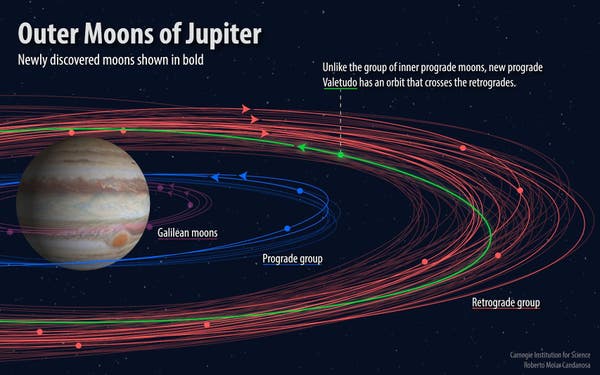What is man, that thou art mindful of him? and the son of man, that thou visitest him? Psalms 8:3-4
The heavens declare the glory of God; and the firmament showeth his handiwork. Psalms 19:1
Thou art worthy, O Lord, to receive glory and honour and power: for thou hast created all things, and for thy pleasure they are and were created. Revelation 4:11
Outer Moons of Jupiter
I can't keep up with these discoveries; I remember when the total number of Jupiter's moons was 12. As reported by Andrew Griffin of the London Independent, July 17, 2018:
Scientists have found 12 new moons orbiting around Jupiter, in a breakthrough discovery about our mysterious neighbour.
They include an object that scientists have referred to as an “oddball”. It is just one kilometre in size, and is flying in the opposite direction to many of the planet’s moons – and behaves in an entirely different way to any of the other 78 objects orbiting the planet.
As such, it might be responsible for having smashed up many of the other objects that make up the moons around Jupiter. Scientists think the vast number of objects orbiting the planet are probably the result of collisions earlier in its life, which have been captured by Jupiter and now continue to orbit it.
The tiny moon – which is set to be named Valetudo, after the Roman god Jupiter’s great-granddaughter – is likely to continue having such collisions and could destroy itself, said scientists.
“This is an unstable situation,” said Scott S Sheppard, who helped lead the team who found the moons. “Head-on collisions would quickly break apart and grind the objects down to dust.”
Sheppard told The Independent: “It is as if the moon is travelling the wrong way down a crowded highway,” adding that it is far more likely that it would have a dangerous crash.
The new discoveries take the total number of objects found around the planet up to 79. Scientists expect there are probably around 100 different objects in total.
Saturn, Jupiter’s closest rival, has a mere 62 moons orbiting around it.
All of the new moons around Jupiter are less than two miles wide. That accounts for why they had been left undiscovered until now, when scientists found them using incredibly sensitive telescopes.
The team behind the discovery also found the most distant known object in our solar system – and suggested there might be a mysterious planet, a Planet X or Planet Nine, hiding out in the depths of our solar system. The new discovery was made almost by accident as researchers were hunting for more evidence of that world beyond Pluto.
“Jupiter just happened to be in the sky near the search fields where we were looking for extremely distant solar system objects, so we were serendipitously able to look for new moons around Jupiter while at the same time looking for planets at the fringes of our solar system,” said Sheppard.
Finding how the objects came to be formed and orbit around Jupiter could shed light on the formation of our own solar system. For instance, the new moons are so small that they would be influenced by any gas and dust around the planet – the fact they have managed to survive suggests they formed after the rotating disk of gas and dust that surrounded the sun formed into planets.


.jpg)



































No comments:
Post a Comment